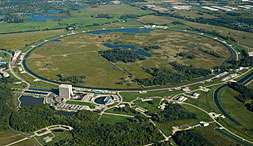The hunt for the Higgs steps up a gear

The hunt for the Higgs boson, the most highly sought-after particle in physics, received a boost this month with the release of two new results from the Tevatron particle collider at the US Department of Energy's Fermilab in Illinois.
Scientists working on the DZero particle detector experiment, including physicists from Imperial College London, have for the first time successfully observed pairs of Z bosons at the Tevatron. Pair production of these force carrying particles is extremely rare and difficult to detect, and researchers say that having observed them represents a big step towards observing the Higgs boson itself.
Then just a week after spotting the Z boson pairs, DZero scientists, along with colleagues from the CDF collaboration at the Tevatron, were able to rule out the possibility of the Higgs boson having a mass of around 170GeV/c2 – a value which lies in the mass range scientists believe the Higgs may have. This is the first time that any experiment in the world has ruled out potential values for the mass of the Higgs boson since the Large Electron -Positron Collider at CERN proved that the Higgs could not have a mass of less than 114GeV/c2 in 2000.
Dr Gavin Davies from Imperial's Department of Physics, co-leader of the Higgs hunting group on the DZero experiment, explains: "We now know that the Higgs boson does not have a mass of 170GeV/c2. If it did have this mass, then we should have seen evidence for it at the Tevatron by now. Ruling out possible masses of the Higgs is a very important part of the hunt for this elusive particle."
The Standard Model of particle physics predicts the existence of a particle, known as the Higgs boson, which gives mass to other particles. Currently, the mechanism by which particles acquire different mass values is unknown, and finding evidence for the existence of the Higgs boson would solve this fundamental mystery of nature.
The first of the Tevatron results, where pairs of Z bosons were observed, is a big step towards finding the Higgs boson because the pairs' experimental signature and characteristics are similar to those that would be seen if the Higgs was produced. In addition, the analysis methods and techniques used to find the Z bosons pairs are similar to those for finding the Higgs too.
So the Tevatron scientists have proven that their observation methods work, and that they are capable of observing very rare processes like those required to produce the Higgs.
Creating the experimental conditions in which the Higgs boson could be observed is extremely difficult. It requires very powerful particle collisions, and super-sensitive detectors to record the results of the collisions. To find the pairs of Z bosons, the DZero detector had to search through nearly 200 trillion particle collisions.
Dr Davies says that the results from the Tevatron signal the start of a new exciting phase of Higgs physics: "The observation of the very rare ZZ process is a real stepping stone to the Higgs. Following this with the first direct Higgs mass exclusion since 2000 is tremendously exciting.
"It shows that the Tevatron experiments are very much in the race for finding the Higgs," he added.
DZero is an international experiment conducted by around 600 physicists from 90 institutions in 18 different countries. Currently around 10 Imperial physicists are involved with the experiment, based either full or part time at Fermilab.
This autumn the Large Hadron Collider (LHC) particle accelerator at CERN in Switzerland will be switched on to perform particle collisions at even higher energies than the Tevatron. Observing the Higgs boson is also a key goal for the detector experiments at CERN. A large cohort of Imperial physicists are working on the LHC detectors, including Professors Tejinder Virdee and Andrei Golutvin, who are lead scientists on the CMS and LHCb detectors respectively.
Provided by Imperial College London




















